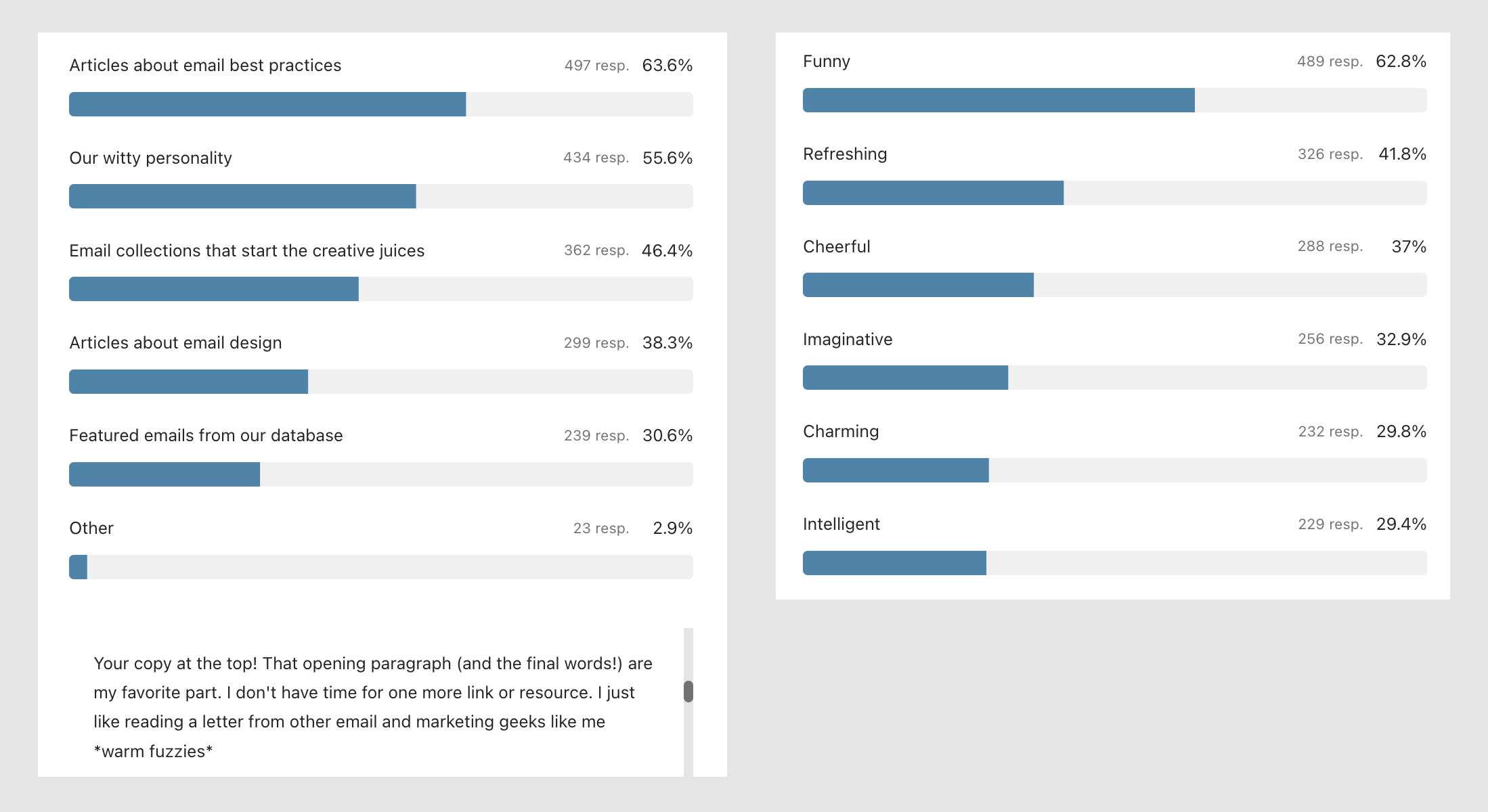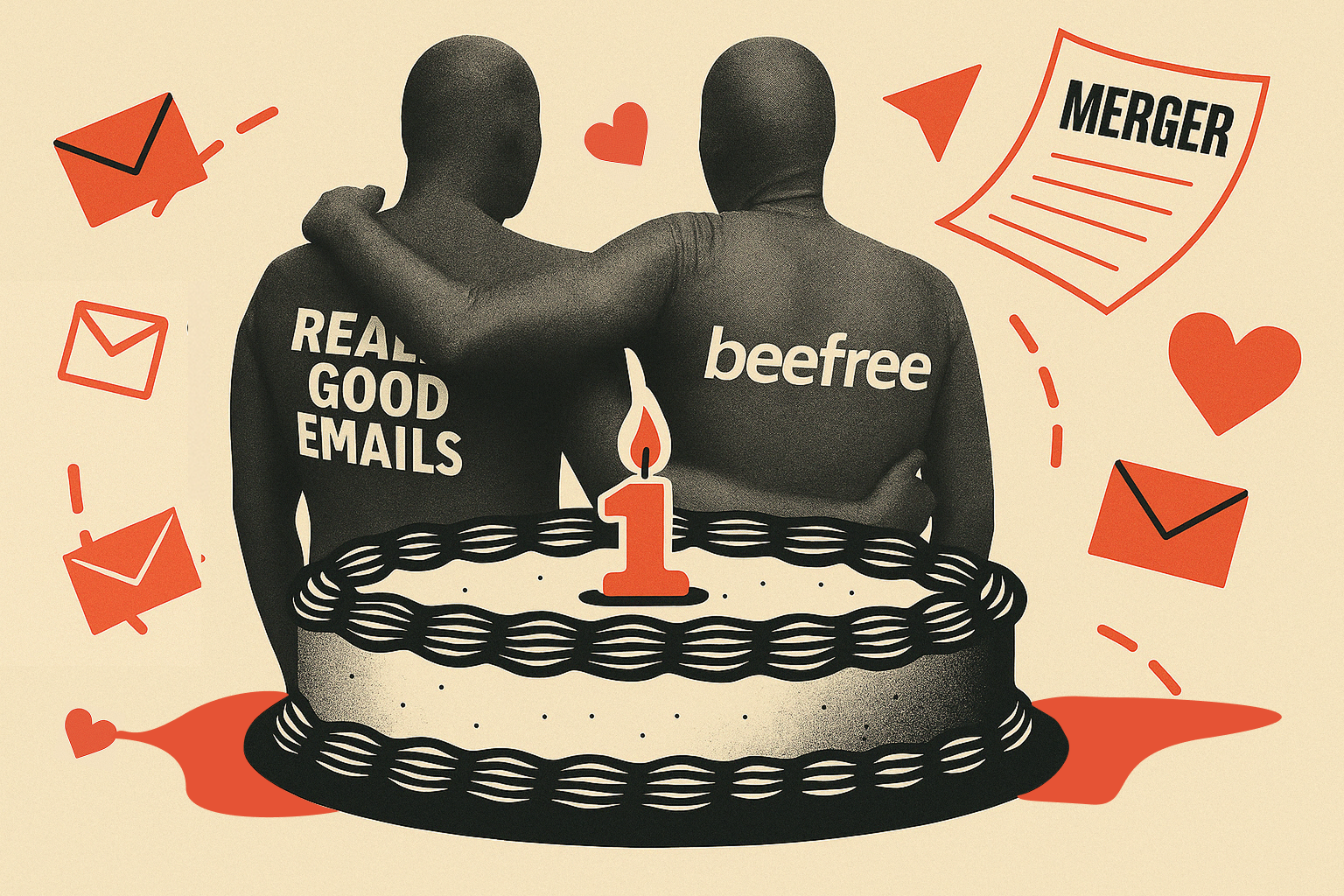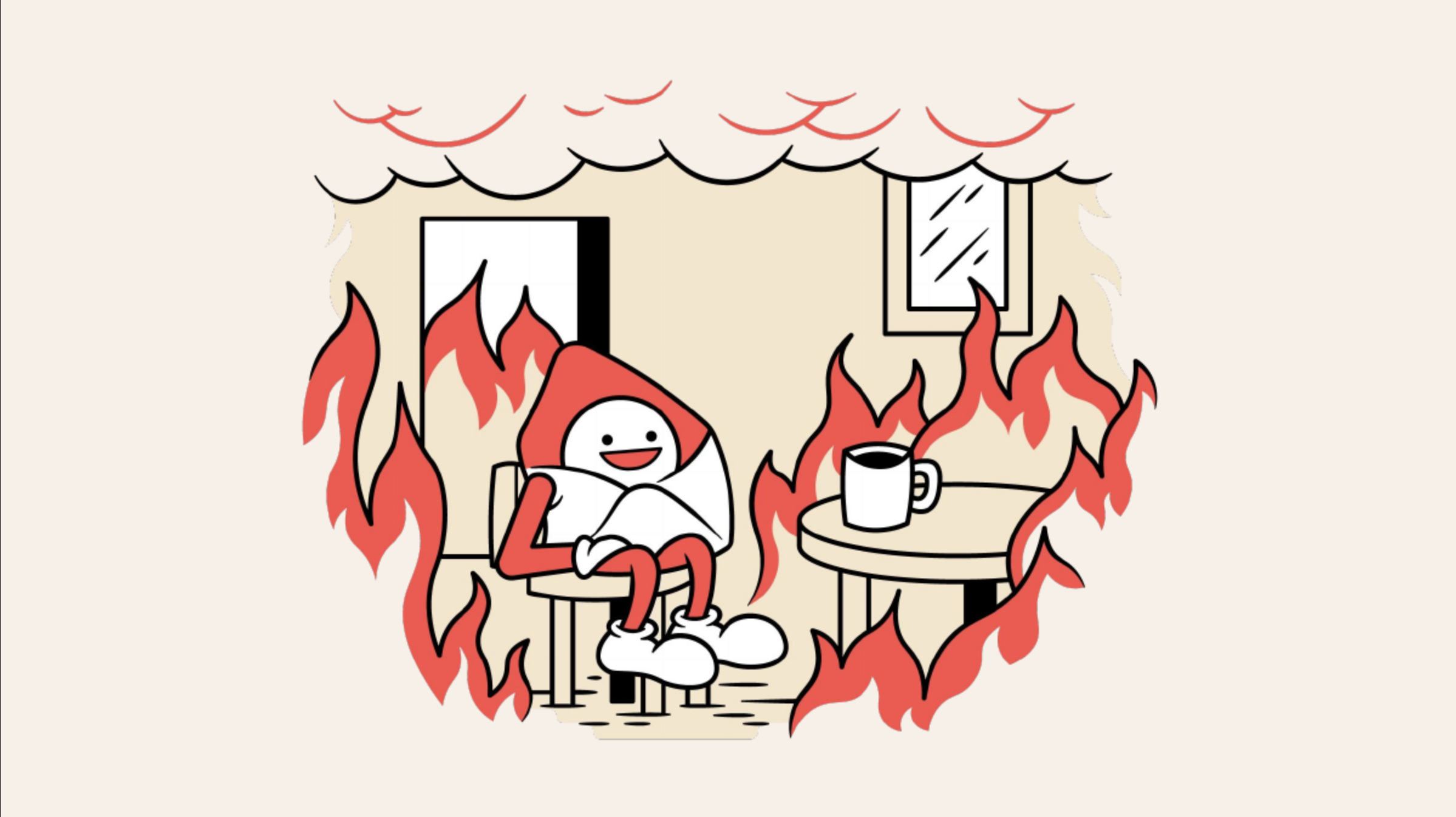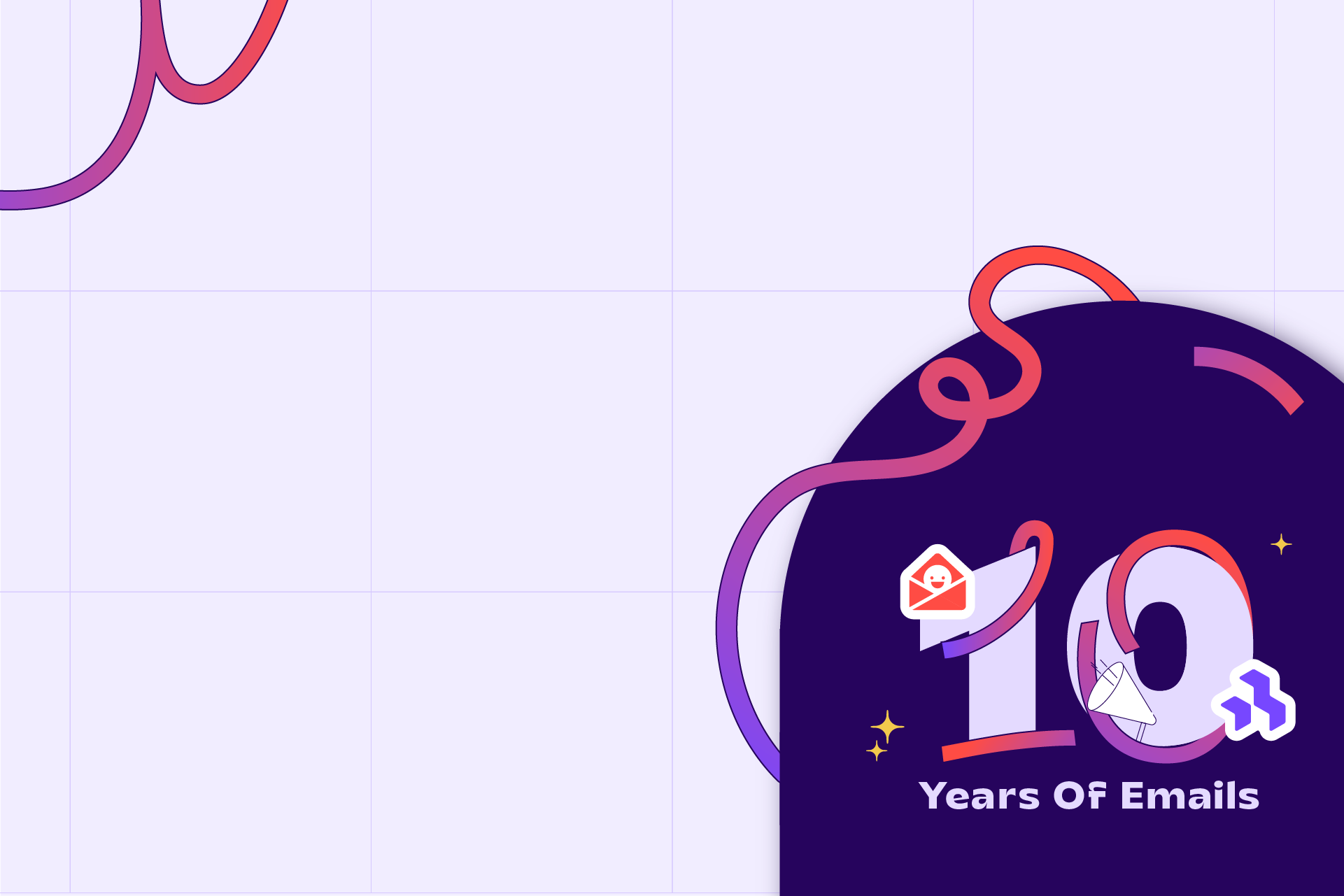What’s the secret to building a newsletter people actually want to read—for ten years straight?
We’ve asked ourselves that question a lot. There’s no shortage of abandoned or bad newsletters out there—ones that started strong but faded into the inbox void, victims of inconsistent sends, content that lacked relevance, or the dreaded "we’ll pick this back up next quarter" promise. So how did we not only survive but grow to 250,000+ subscribers, all while keeping our sanity (mostly) intact?
The truth is, we didn’t have some genius strategy when we started. We just had one desire: to make it fun.
If we were going to handcuff ourselves to hours of writing and researching, we wanted to make it enjoyable for ourselves. So roughly a year after launching ReallyGoodEmails.com (and after a while of feeling hypocritical that we were judging others' emails without having our own), we set out to make something that we too could be judged on.
We launched our newsletter in February 2015. It wasn't that great, to be honest. The content was just our top five favorite emails that we found that week (back in those days, RGE was set up like a blog and there weren't any community submissions or a good search filter). Honestly, with our full-time jobs and family life, I was surprised we had time to write and code the newsletter on top of everything else we were doing to keep it going as a side project. We weren’t sure if anyone would care to read it. We just wanted to share cool emails and sneak in a few questionable jokes.
Fast forward a decade, and somehow, this weird little newsletter became one of the best things we’ve ever done for RGE. We land in our readers’ inboxes twice a week—keeping us top of mind when they start thinking about building emails. More than that, it has helped us craft our quirky brand voice and turn into a full-fledged growth engine for RGE and Unspam.
That’s the power of a personable, consistent newsletter: it builds loyalty, grows your audience, and makes people actually remember you. It didn’t happen overnight, and we made a lot of mistakes along the way. The thing about email newsletters, unlike a blog article like this, is that they give you instant feedback. And over the years, we’ve been able to harness that feedback and ask people why they read our newsletter.

If you’re looking to build a newsletter people actually want to read, here’s what we’d do (and avoid) based on 10 years of experience. Ten ideas. Ten tips. Ten years. That has a nice ring to it, doesn’t it?
But before we jump into the 10, there’s plenty of advice out there for newsletter building. Many best practices are common knowledge, but for those who want a quick recap of what most people will tell you to do when building a newsletter, here’s a quick summary:
- Launch and iterate quickly.
- Don’t obsess over what others are doing.
- Ask your readers for feedback.
- Keep it focused.
- Treat your newsletter like an ongoing conversation.
- Write about something you know well.
- Don’t worry about how many people sign up, worry about those who actually read it.
- Follow a calendar so your readers come to expect your newsletter’s cadence.
(I just looked at the top 20 results on “how to write a newsletter” and they pretty much say the same thing. And then try to get you to buy their email software.)
Even though that’s sound advice, there’s another level when you’ve been around the block as long as we have. Yes, you should continue to do those things (they are more like table stakes), but here are the things that we learned the hard way that no one told us about:
1. Consistency wins (even when you have no idea what you’re doing)
When we started, we weren’t thinking about long-term strategy—we just showed up, wrote something, and sent it. But sticking to a schedule (twice a week!) forced us to get better at writing, curating, and finding our voice. Even when we were traveling (like I’m doing right now), we had committed to hit "send" on something we would’ve wanted to read ourselves. That consistency is what built an audience over time—not because we were ticking a box on a calendar, but because we were showing value regularly.
Tip: Pick a frequency you can realistically maintain. Once a week is great. Once a month? Still solid, but you can probably do better. Just don’t be the person who disappears for six months and expects people to remember you. The more you write, the better you get. Keep showing up.
2. Make it forward-worthy
A huge chunk of our growth came from people forwarding our newsletter to friends, coworkers, and that one guy who still doesn’t believe email is a real marketing channel. The more we leaned into humor, useful insights, and slightly unhinged commentary, the more people shared it. Additionally, we would see big spikes of shares when we personalized the message where possible, like a hero image with a subscriber’s name in it (or some other personal favorites: creating a rap name for every subscriber, segmenting each subscriber by their birthday and writing them a ridiculous horoscope, or creating a shrine with their picture and the last day they visited the site.) We also include share links at the bottom of every email, but let’s be real—those rarely get clicked.
Tip: Ask yourself, would I forward this? Maybe not. Would I bring it up with others? Getting closer. If not, it might need a better hook, a stronger POV, or at least one mention of toilets.
3. Don’t let perfection kill your momentum
Some of our best emails were written quickly. Some of our worst ones? The ones we overthought, over-edited, and tried too hard to make "perfect." It turns out that being human, weird, and occasionally chaotic is more relatable than being polished to death.
Tip: Write like a human, not a brand. If you wouldn’t say it out loud, don’t write it. And if you find yourself obsessing over a single sentence for 20 minutes? Move on.
4. Don’t be boring. Be entertaining.
Plenty of newsletters exist just to check a marketing box. That’s why they suck. Our goal has always been to make opening our email feel like a little inbox treat. Sometimes that means experimenting with formats, sometimes it means being nostalgic, and sometimes it means throwing the whole thing away and starting over. You can be informative, but you can also be entertaining. That’s the sweet spot when you marry the two.
Tip: Surprise your readers. Throw in a stretched analogy. Try a new format. Break a rule. Just don’t be another forgettable email sitting between a receipt and a LinkedIn request from a guy named Chad.
5. Keep your topics (and your sanity) in check
Writing two newsletters a week for 10 years means I’ve written… hold on… checks calculator… over 1,000 emails. That’s a lot of topics to cover without running out of ideas—or slipping into the dreaded 'uhhh, what do we write this week?' panic mode. Let rule #1 (consistency) be the fire under your butt to continuously look for new things to write about.
Tip: Keep a running list of ideas. Pay attention to trends. And if all else fails, find a weird thing on the internet that your segment of readers most likely saw.
6. Give people a reason to stay (or come back)
We’ve never chased vanity metrics. We’ve focused on making something that people want to open at least once per week. That means respecting our readers’ inbox space, not tricking them into clicks, and making it clear why they should stick around. (In our case, they are getting smarter by reading the articles we’ve curated, which will help them in their careers and look good in front of their bosses.)
Tip: Give value first. Entertain, educate, or at least make someone chuckle before you ask them to do anything. People will stay subscribed when they feel like they’re getting something, not just being marketed to. Make it easy to unsubscribe. Clean your list. The goal isn’t to collect email addresses—it’s to build a real audience that wants to be here.
7. Subject lines matter (but not how you think)
We’ve tested a lot of subject line strategies—puns, curiosity gaps, clickbait (we regret that one), a single poop emoji (we didn’t regret that one), and famous lyrics from Taylor Swift and other pop artists. What we’ve found? A subject line is a branding moment that needs to match expectations. You wouldn’t expect Duolingo to have a subject line like “Come back to the app, please”, right? They’d have something like “Your Italian skills are getting moldy 🤢”. Your newsletter subject line is an extension of your newsletter’s voice and topic.
Tip: Be intriguing, but deliver on your promise. And when in doubt, pull a famous quote or catchphrase to use.
8. Repeat the basics
As the months go on, the more you will want to avoid repeating yourself. This is probably a good method if your subscriber base isn’t growing and they always read your stuff, but newbies will be joining all the time who haven’t read your newsletter before. I don’t mean that you should resend to non-openers; what I mean is that it is okay to revisit topics you’ve written about before. It is also inevitable if your industry has some seaonality to it, like we see in email marketing. Do you know how many times I’ve written about Black Friday emails? More times than I can count on a poorly AI-generated hand.
Tip: Revisit your most popular topics at least once per year. You don’t need reinvent the wheel when you do so—use what you’ve done before and update it so it is timely and feels fresh to people who may have seen the topic before. These kinds of newsletters take less time to make too (since you’ve already done the heavy lifting), so I like to schedule them during busy times of my life.
9. Keep an eye on click trends
After you’ve been sending for a long time, you will come to see patterns in your readers’ click behaviors. For us, we have different sections of our newsletter: The hero section (which is our “reason/topic” for sending), a list of curated articles from around the web, a featured GIF we found from the RGE site, and a weird poll at the end. Each section serves its purpose to drive engagement, and we have a pretty good guess on the low and high bands of clicks each section will get with each send. When a section gets lower clicks than expected, we know we missed the mark. If it gets higher than expected, we know we did a great job. If every section is below or above, we know that is something external and we need to do some investigating.
Tip: Your above average clicks are the topics you can revisit later (see #8). Don’t get discouraged by one email’s lackluster performance. Use it as an opportunity to test something new—whether it’s a format change, shorter copy, or tweaking CTA placement. If clicks are falling gradually across the board, you may be sending too much or your content has fallen into a “boring” state.
10. Play the Long Game
A great newsletter isn’t built in a month. It took years for RGE’s newsletter to hit 250k subscribers, and most of that growth happened because we kept showing up and delivering value. But also, more importantly, we rarely ask our readers to do something for our gain in our newsletter. As your audience grows sustainably, you’ll find ways to leverage long-term thinking for your benefit. Every year when we launch Unspam or ask people to take our Annual Survey Thingy, there’s built-up reciprocity there and we see a flood of action.
Tip: Don’t expect overnight success. Use data as a guide, but don’t let it make you paranoid. One "meh" email isn’t the end of the world. The real goal? Making people actually want to see your name in their inbox. Write for the people who do read your emails, not the ones who ignore them. When you focus on quality, the audience will come. And when the audience comes, you are able to do bigger things.
11. Do things that don’t scale
For an entire year after we launched our newsletter, I personally emailed every new subscriber each Sunday to thank them. This wasn’t an automated thing; I would look at their company domain, look at their linkedin profile, and then ask them about what they did in their role or if they knew anyone else that would benefit from the newsletter. Often after doing so, the following week I’d have a reply and another subscriber from someone on their team.
Our monthly recap of the best-performing emails is another task that takes a sh*t-ton of time. Hours of research goes into it each month, pulling data, looking for trends, following why certain emails are gaining over others.
Then there are the ‘fun’ ideas we can’t do with every send (mostly because of cost). Things like sending readers a Black Friday shot clock, donating to causes we care about, or making up thousands of rapper names for each subscriber.
Tip: Come up with something that would make a big impression and spend your time on that thing. Make sure you have at least one of these things every quarter. People love it when you go above and beyond for them and don’t expect anything in return.
The #1 Lesson After 10 Years of Newsletter Writing
At the end of the day, the secret to a successful newsletter isn’t some hidden growth hack or a fancy automation trick—it’s showing up consistently, writing something people actually want to read, and making it worth sharing. There’s no shortcut for creating something that earns a spot in your readers’ inbox week after week. You can A/B test your subject lines all you want, optimize your CTAs, and fine-tune your send times, but if the content inside isn’t compelling, none of that will matter. The newsletters that stick around aren’t the ones with the best marketing tactics—they’re the ones that build a habit with their audience by delivering real value, time after time.
Because here’s the hard truth: If your newsletter is forgettable, nothing else matters. Your readers are getting hundreds of emails a day. They don’t owe you their attention. If they open your newsletter and skim through it without feeling entertained, informed, or at the very least, mildly amused, they won’t be back. That’s why the biggest lesson from running RGE’s newsletter for ten years is this—be memorable. Make your content distinct, write with a point of view, and give people a reason to look forward to your email instead of letting it get buried under a pile of promotions. If you can do that, your newsletter won’t just last—it’ll become the one email people actually look forward to opening.


